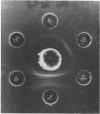Abstract
Staphylococcal hyaluronate lyase (hyaluronidase) derived from a pathogenic strain of staphylococcus was purified by means of salt fractionation with ammonium sulfate and gel filtration through Sephadex G-100. Most of the enzyme activity from concentrated culture supernatant fluids of staphylococci was obtained in a fraction precipitated by 90 to 100% saturation with ammonium sulfate. A small amount of enzyme was also precipitated by 80 to 90% saturation with the salt. The hyaluronidase-rich fractions did not contain other staphylococcal enzymes, such as coagulase, protease, lipase, and staphylokinase. These enzymes were present in the original concentrates. Molecular sieving chromatography of the partially purified enzyme by filtration through Sephadex G-100 resulted in a further increase in specific enzyme activity. However, more than one active peak was obtained after gel filtration, thus suggesting that there may be more than one molecular form of the enzyme. Immunodiffusion in agar gel of the chromatographically purified enzyme fraction, with immune serum from rabbits injected with concentrated staphylococcal culture supernatant fluids, indicated that there was one major antigen. A similar antigen, giving reactions of identity with the purified material, was present in the original culture supernatant fluid.
Full text
PDF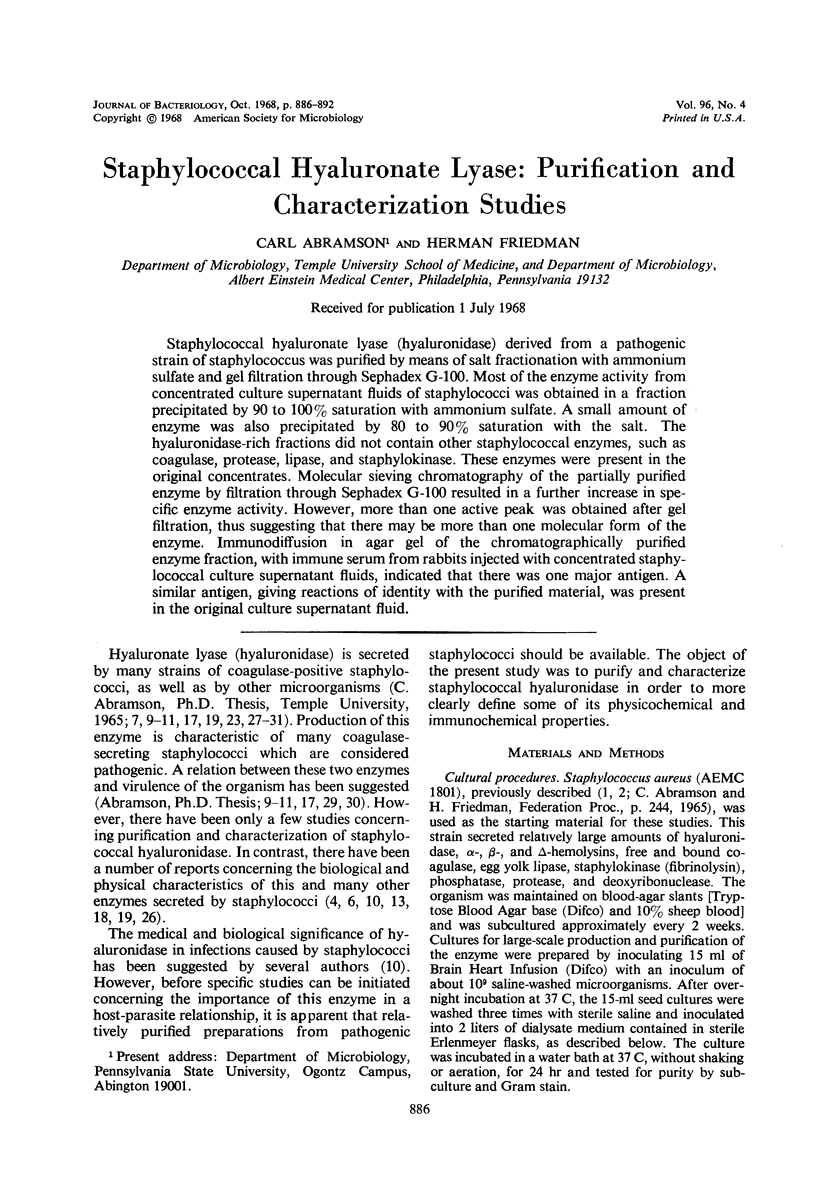
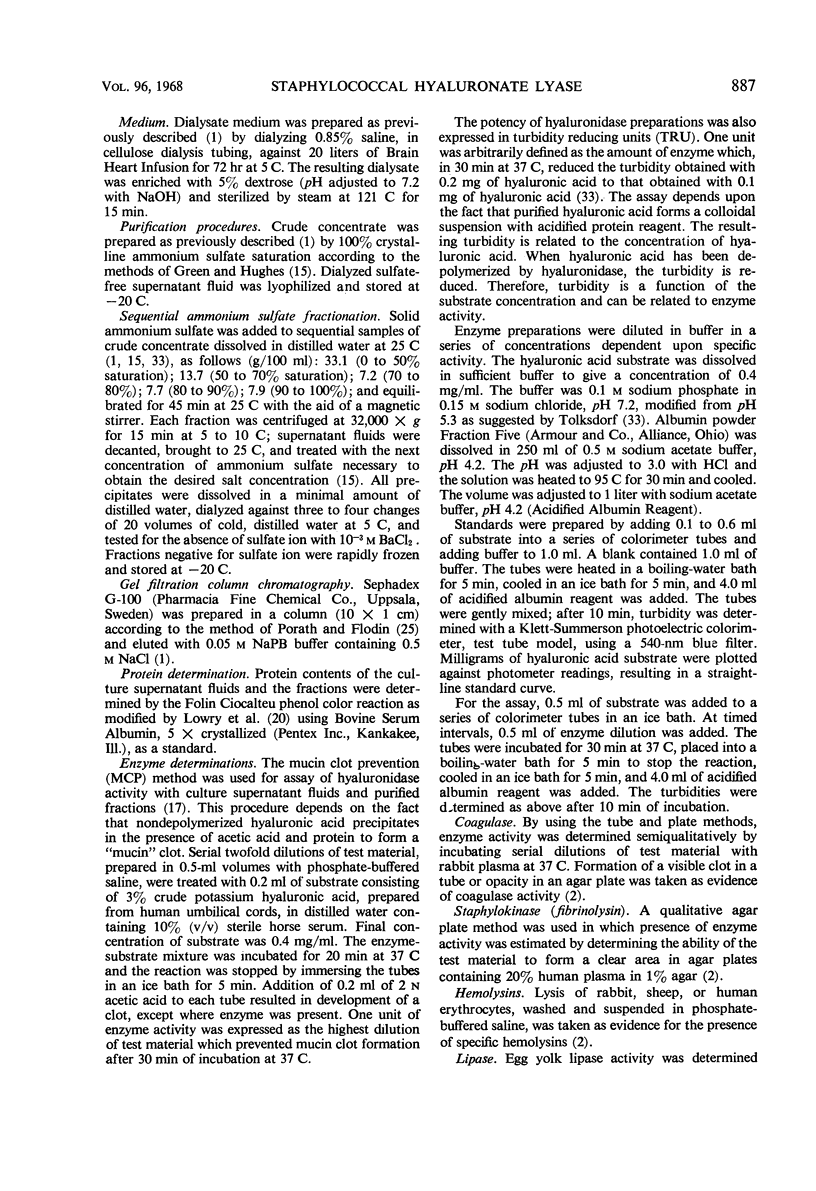
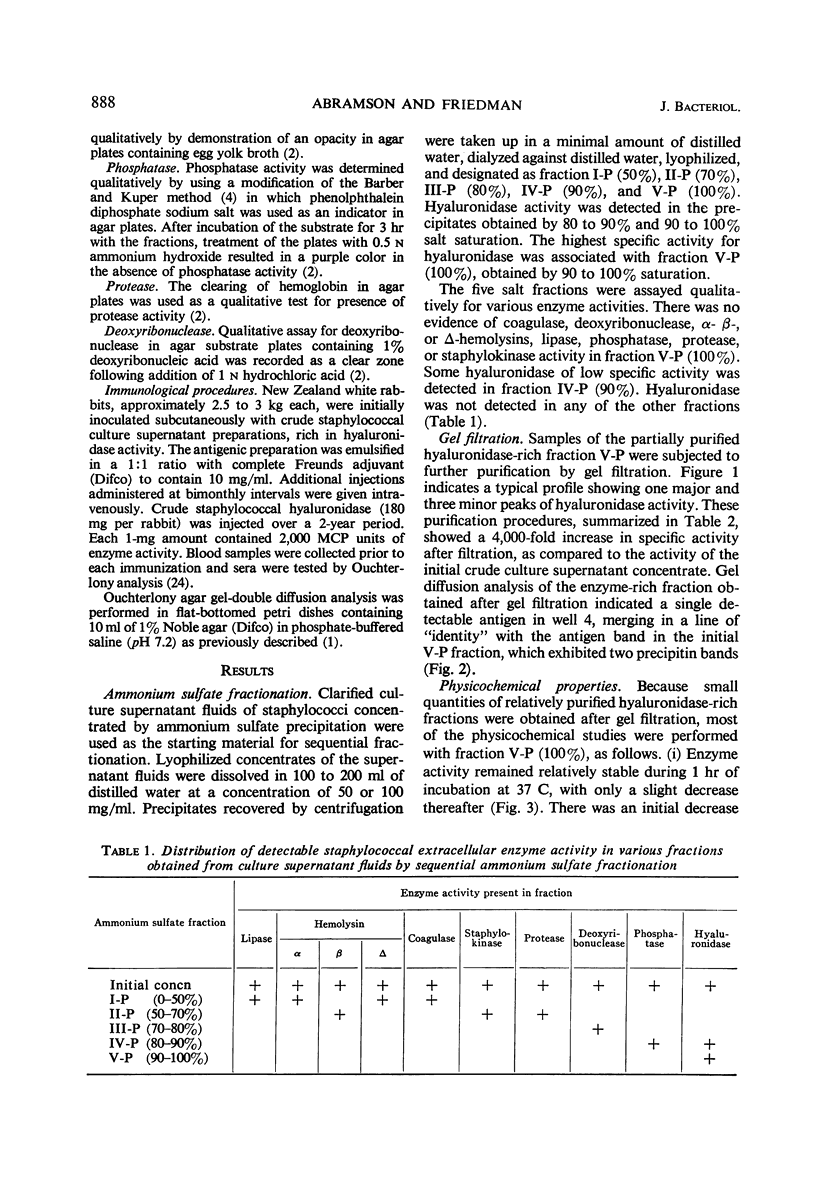
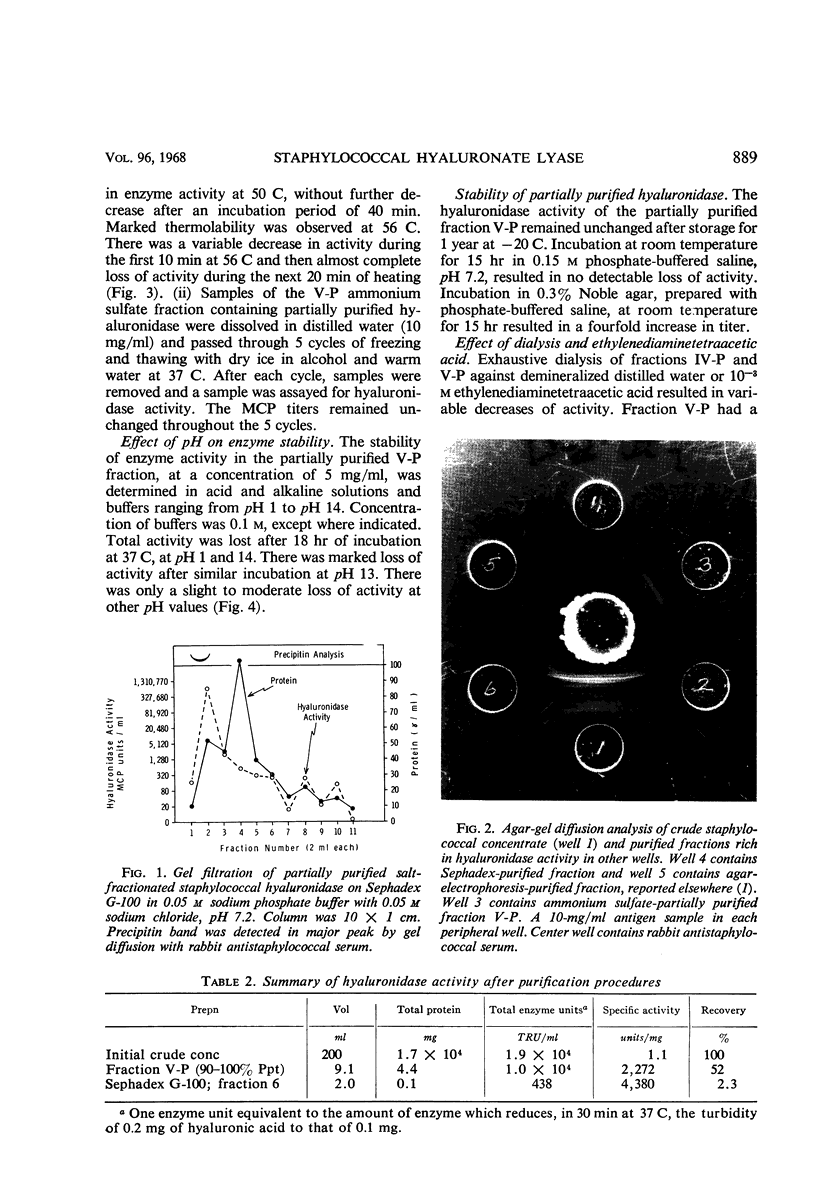
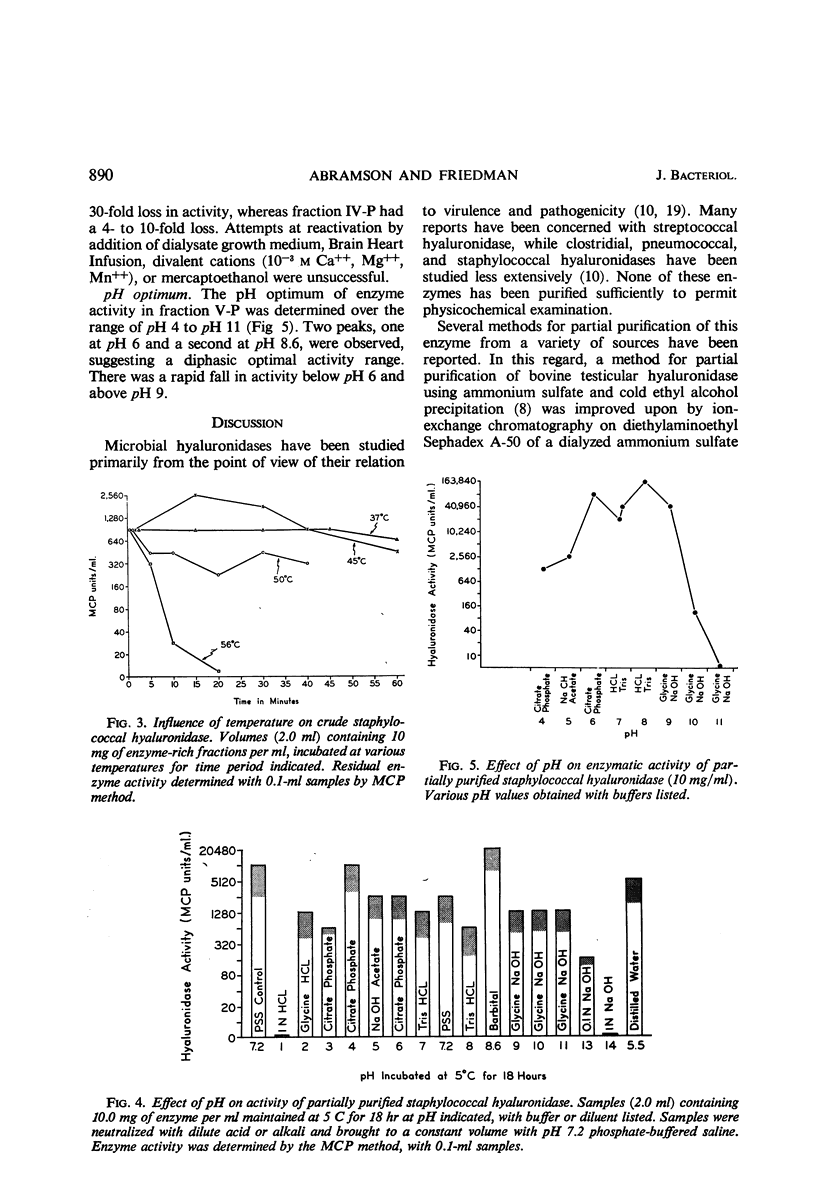
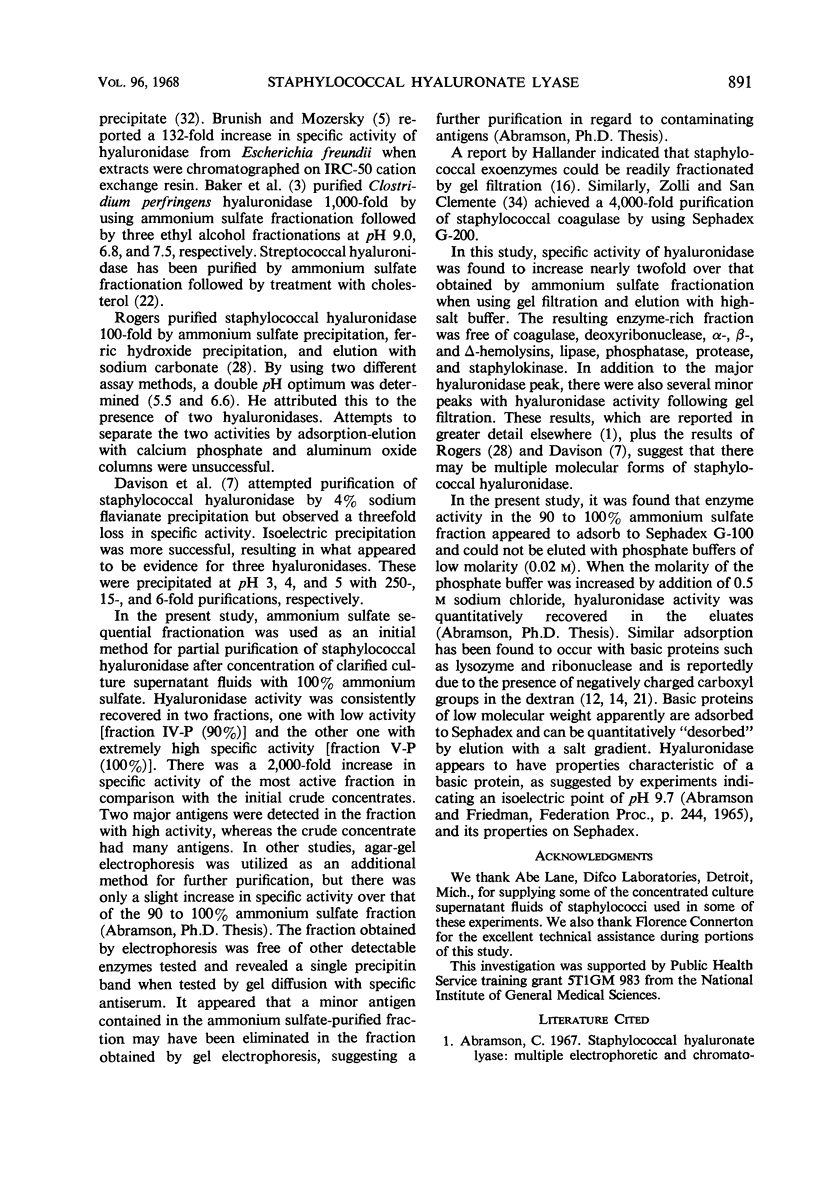
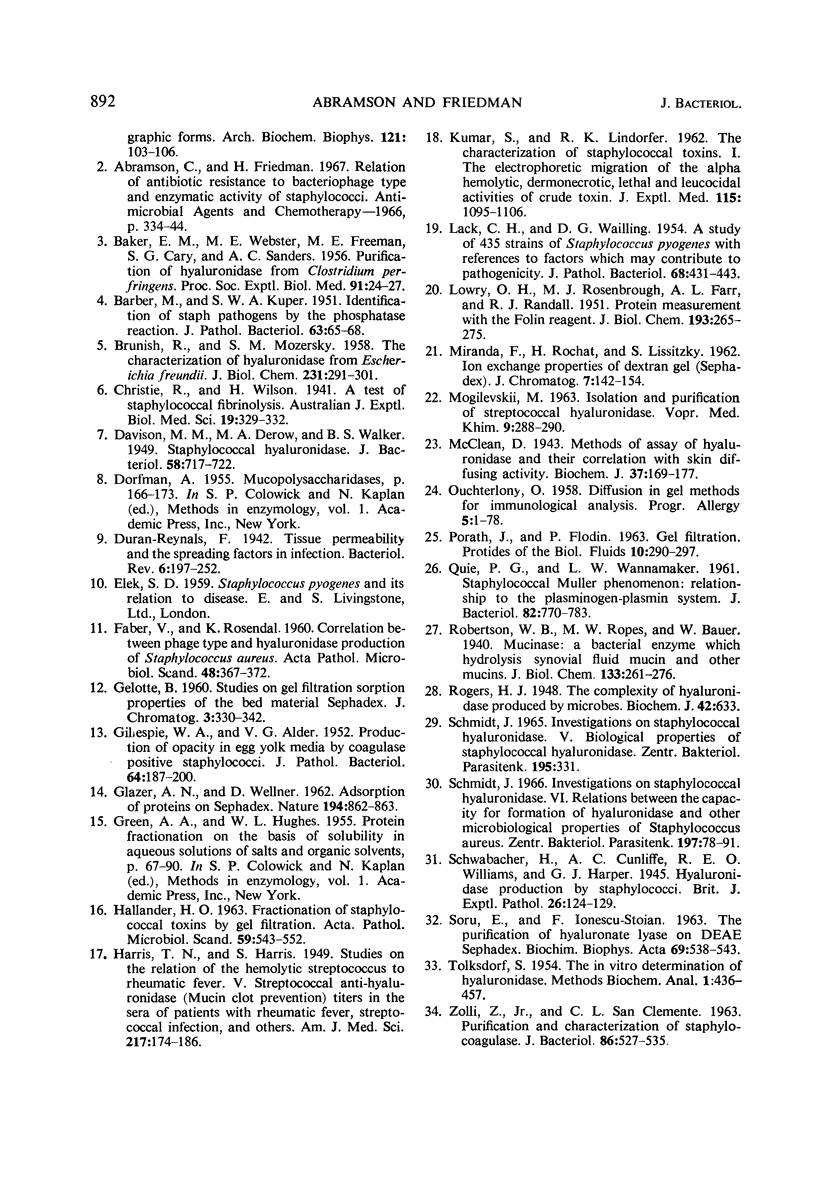
Images in this article
Selected References
These references are in PubMed. This may not be the complete list of references from this article.
- BAKER E. M., WEBSTER M. E., FREEMAN M. E., CARY S. G., SANDERS A. C. Purification of hyaluronidase from Clostridium perfringens. Proc Soc Exp Biol Med. 1956 Jan;91(1):24–27. doi: 10.3181/00379727-91-22158. [DOI] [PubMed] [Google Scholar]
- BARBER M., KUPER S. W. A. Identification of Staphylococcus pyogenes by the phosphatase reaction. J Pathol Bacteriol. 1951 Jan;63(1):65–68. doi: 10.1002/path.1700630108. [DOI] [PubMed] [Google Scholar]
- BRUNISH R., MOZERSKY S. M. The characterization of hyaluronidase isolated from Escherichia freundii. J Biol Chem. 1958 Mar;231(1):291–301. [PubMed] [Google Scholar]
- DAVISON M. M., DEROW M. A., WALKER B. S. Staphylococcal hyaluronidase. J Bacteriol. 1949 Dec;58(6):717–722. doi: 10.1128/jb.58.6.717-722.1949. [DOI] [PMC free article] [PubMed] [Google Scholar]
- Duran-Reynals F. TISSUE PERMEABILITY AND THE SPREADING FACTORS IN INFECTION : A Contribution to the Host:Parasite Problem. Bacteriol Rev. 1942 Dec;6(4):197–252. doi: 10.1128/br.6.4.197-252.1942. [DOI] [PMC free article] [PubMed] [Google Scholar]
- FABER V., ROSENDAL K. Correlation between phage-type and hyaluronidase-production of Staphylococcus aureus. Acta Pathol Microbiol Scand. 1960;48:367–373. doi: 10.1111/j.1699-0463.1960.tb04780.x. [DOI] [PubMed] [Google Scholar]
- GILLESPIE W. A., ALDER V. G. Production of opacity in egg-yolk media by coagulase-positive staphylococci. J Pathol Bacteriol. 1952 Jan;64(1):187–200. doi: 10.1002/path.1700640119. [DOI] [PubMed] [Google Scholar]
- GLAZER A. N., WELLNER D. Adsorption of proteins on 'Sephadex'. Nature. 1962 Jun 2;194:862–863. doi: 10.1038/194862a0. [DOI] [PubMed] [Google Scholar]
- HALLANDER H. O. FRACTIONATION OF STAPHYLOCOCCAL TOXINS BY GEL-FILTRATION. Acta Pathol Microbiol Scand. 1963;59:543–552. doi: 10.1111/j.1699-0463.1963.tb01258.x. [DOI] [PubMed] [Google Scholar]
- KUMAR S., LINDORFER R. K. The characterization of staphylococcal toxins. I. The electrophoretic migration of the alpha hemolytic, dermonecrotic, lethal, and leucocidal activities of crude toxin. J Exp Med. 1962 Jun 1;115:1095–1106. doi: 10.1084/jem.115.6.1095. [DOI] [PMC free article] [PubMed] [Google Scholar]
- LACK C. H., WAILLING D. G. A study of 435 strains of Staphylococcus pyogenes with reference to factors which may contribute to pathogenicity. J Pathol Bacteriol. 1954 Oct;68(2):431–443. doi: 10.1002/path.1700680217. [DOI] [PubMed] [Google Scholar]
- LOWRY O. H., ROSEBROUGH N. J., FARR A. L., RANDALL R. J. Protein measurement with the Folin phenol reagent. J Biol Chem. 1951 Nov;193(1):265–275. [PubMed] [Google Scholar]
- MOGILEVSKII M. Sh. VYDELENIE I OCHISTKA STREPTOKOKKOVO I GIALURONIDAZY. Vopr Med Khim. 1963 May-Jun;9:288–293. [PubMed] [Google Scholar]
- McClean D. Studies on diffusing factors: 2. Methods of assay of hyaluronidase and their correlation with skin diffusing activity. Biochem J. 1943 Jul;37(2):169–177. doi: 10.1042/bj0370169. [DOI] [PMC free article] [PubMed] [Google Scholar]
- OUCHTERLONY O. Diffusion-in-gel methods for immunological analysis. Prog Allergy. 1958;5:1–78. [PubMed] [Google Scholar]
- QUIE P. G., WANNAMAKER L. W. Staphylococcal Muller phenomenon: relationship to the plasminogen-plasmin system. J Bacteriol. 1961 Nov;82:770–783. doi: 10.1128/jb.82.5.770-783.1961. [DOI] [PMC free article] [PubMed] [Google Scholar]
- Rogers H. J. The complexity of the hyaluronidases produced by micro-organisms. Biochem J. 1948;42(4):633–640. doi: 10.1042/bj0420633. [DOI] [PMC free article] [PubMed] [Google Scholar]
- SORU E., IONESCU-STOIAN F. The purification of hyaluronate lyase on DEAE-sephadex. Biochim Biophys Acta. 1963 Mar 5;69:538–543. doi: 10.1016/0006-3002(63)91305-2. [DOI] [PubMed] [Google Scholar]
- Schmidt J. Untersuchungen über Staphylokokken-Hyaluronidase. IV. Vergleichende Untersuchungen über die Hyaluronidasebildungsfähigkeit des Staph. aureus in vitro und in vivo. Zentralbl Bakteriol Orig. 1965 Feb;195(3):326–331. [PubMed] [Google Scholar]
- Schmidt J. Untersuchungen über Staphylokokken-Hyaluronidase. VI. Untersuchungen über Beziehungen zwischen Hyaluronidase-bildungsvermögen und anderen mikrobiologischen Eigenschaften des Staph. aureus. Zentralbl Bakteriol Orig. 1965 Jul;197(1):78–91. [PubMed] [Google Scholar]
- TOLKSDORF S. The in vitro determination of hyaluronidase. Methods Biochem Anal. 1954;1:425–457. doi: 10.1002/9780470110171.ch15. [DOI] [PubMed] [Google Scholar]
- ZOLLI Z., Jr, SANCLEMENTE C. L. PURIFICATION AND CHARACTERIZATION OF STAPHYLOCOAGULASE. J Bacteriol. 1963 Sep;86:527–535. doi: 10.1128/jb.86.3.527-535.1963. [DOI] [PMC free article] [PubMed] [Google Scholar]



